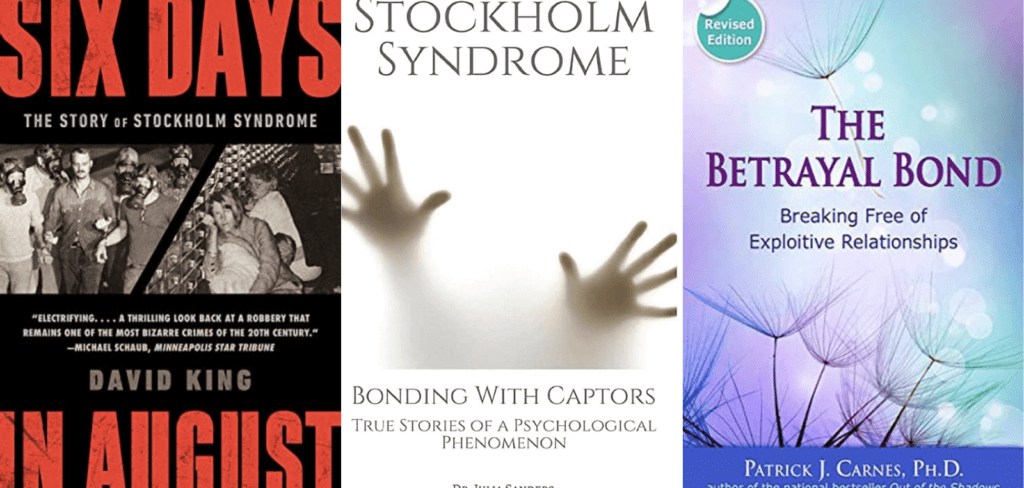This post contains trauma bonding test along with helpful tips to break it.
We usually think of bonding as something positive, such as marital bonds.
However, bonds are neutral. They can be positive or negative.
What Is A Trauma Bond?
What Does Trauma Bond Mean?
Trauma bond is a highly addictive attachment to the people who have hurt you.
You may blame yourself for the abuse. You may even convert them into non-abusers by trying to help them understand what they are doing. (*)
This attachment can cause you to distort your own reality and distrust your own judgment. What’s worse, it’s a guarantee of more pain. (*)
In fact, on average, high-risk victims live with domestic abuse for 2.3 years and medium-risk victims for 3 years before getting help. (*)
Adult survivors of abusive and dysfunctional families are more likely to struggle with trauma bonding.
Trauma bonding can happen in different situations:
- Child abuse
- Family systems
- Domestic violence
- Dysfunctional relationships
- Divorce
- Exploitation in the workplace
- Hostage negotiation
- Kidnapping
- Cults and Religious abuse
Such situations can involve exploitation of trust, power, or both.
Related: 7 Stages Of Trauma Bonding (+FREE Worksheets)
Trauma Bonding Test
Results
#1. Do you find yourself constantly covering up and explaining a relationship even though others around you have strong negative reactions to the relationship?
#2. Do you continue to believe their false promises even though they’ve constantly proven to be unreliable?
#3. Do you feel loyal to them even when you know their secrets are damaging to others?
#4. Do you find yourself missing and even longing for them even though they were destructive to you?
#5. Do you go “overboard” to help them even though they are destructive to you?
#6. Do you work so hard to please them even though they are clearly using you?
#7. Do you choose to stay in unhealthy relationships even though it would cost you nothing to walk away?
#8. Are you unable to detach from the person even though you don’t trust them or like them?
#9. Do you find yourself continuing to seek contact with them when you know they will cause you more pain?
#10. Do you find yourself attracted to untrustworthy people?
We will not sell your information. All results are kept confidential.
This quiz is for informational purposes only. It is not meant as a diagnostic or assessment tool.
Results
The questions above represent common signs of trauma bond. If you answered yes to most of these questions, then trauma bond may be a problem for you.
Stockholm Syndrome vs. Trauma Bond
Stockholm syndrome is one type of trauma bonding.
In 1973, hostages were taken as a way to force authorities to release some prisoners during a bank robbery in Stockholm. The captors were threatening to their hostages but there were also moments in which they performed little acts of kindness for the hostages.
When the five-and-a-half-day siege ended and the captors were arrested, everyone was astonished to witness the bond created between the hostages and their captors.
The hostages showed rage and contempt for those who rescued them and refused to testify against their captors and even began raising money for their defense.
Related: Love Addiction Test (+ Resources For Love Addiction)
Trauma Bonds vs. Codependency
Some people might categorize a trauma bond as codependency.
Codependency can be defined as an obsessive attachment to one or more addicted people.
Living with an addict is often traumatizing, which is why many codependents are also trauma-bonded.
Related: Codependent Relationship Quiz (+FREE Codependency Worksheets)
Do you need to be a trauma survivor to experience trauma bonding?
When thinking of trauma, most people think of sexual abuse, war, terrorist events, etc.
But trauma can also be caused by childhood neglect, inconsistent parenting, emotional abuse, divorce, or racism and discrimination.
Cumulative trauma experiences, such as a consistent pattern of childhood neglect can accumulate over time and create serious lifelong wounds. (*)
Related: Top 5 Tips On How To Recover From Love Addiction
Breaking Trauma Bond:
Stages of Recovery From Trauma Bonding
Recovery happens in stages. However, these stages may not be linear and you may oscillate between stages.
1. Denial
Coming out denial requires courage and willingness to see the story as others see it. Group therapy and support groups can be helpful here.
It’s also helpful to write a narrative of your life story as if it were the story of someone else, using third-person pronouns. This can help you see things clearer and find compassion for the character in the story.
Once you finish writing the story, try answering the following questions:
- What feelings do you have for the character?
- What do you wish to tell the character?
Related: How To Step Out Of Denial? Top 10 Steps To Overcome Denial When The Truth Is Heartbreaking
2. Anger
Anger, in and of itself is not a negative emotion. Anger can help you break through denial and motivate you to say “no more” and start a significant change process.
Many people hold onto negative beliefs that prevent them from feeling anger. You may be onto rules, such as “If you cannot say something nice, don’t say anything at all.”
Try writing a letter that you don’t send to explore and express your anger.
Related: Top 45 Breakup Journal Prompts (+Top 20 Breakup Advice To Deal With A Breakup Without Closure)
3. Acceptance
Acceptance means recognizing that your life did not turn out the way you wanted or the way it should have.
This truth is best captured in the serenity prayer that most Twelve-Step programs use: God grant me the serenity to accept the things I cannot change, the courage to change the things I can, and the wisdom to know the difference.
When to Seek Help
Many organizations provide emotional support and advice about staying safe, both during the abuse and afterward.
- the National Domestic Violence Hotline
- The Childhelp National Child Abuse Hotline
- elder abuse hotlines in each state
If you or someone you know is in immediate danger of domestic violence, call 911 or seek emergency help. You can contact the National Domestic Violence Hotline 24/7 via:
- phone, at 800-799-7233
- live chat, at thehotline.org
- text, by texting LOVEIS to 22522
Many other resources are available, including helplines, in-person support, and temporary housing. People can find local resources and others classified by demographics, such as support specifically for People of Color, here:

References
- Traumatic bonding – Wikipedia
- What Is Trauma Bonding? (verywellmind.com)
- Trauma Bonding: What It Is & How to Heal – Choosing Therapy
- Trauma bonding: Definition, examples, signs, and recovery (medicalnewstoday.com)
- What Is Trauma Bonding? Signs To Look Out For | Well+Good (wellandgood.com)
- Understanding the Impact of Trauma Bonds in Our Lives | Psychology Today
- Emotional attachments in abusive relationships: a test of traumatic bonding theory – PubMed (nih.gov)
- Trauma Bonding: What It Is and How to Cope (healthline.com)







